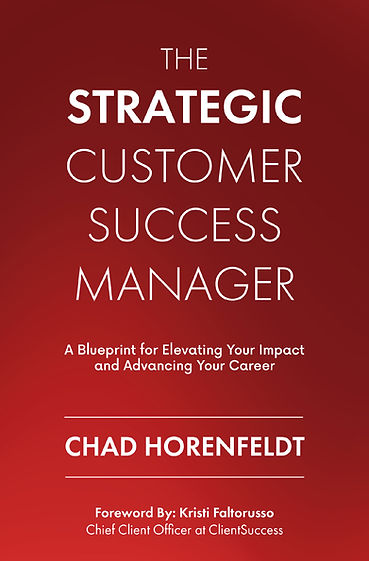What productivity hack strategic CSMs always use to win the week before it starts
- Chad Horenfeldt
- Jul 25
- 3 min read
Sundays are a strange blend of relaxation and anxiety. You might love the downtime—but that creeping feeling of the week ahead? It’s real.
One of the best productivity hacks I’ve ever received came from my mentor, Paul Teshima. His advice was simple: adopt a “Sunday Night Prep” routine. It's something I delve into in chapter 12 of my book, The Strategic Customer Success Manager. I will provide an overview in this post.
It’s not just about planning your week. It’s about clearing your mind, setting priorities, and stepping into Monday with purpose. This ritual—what I call RPM: Reflect, Prep, Monitor—has become my go-to system for success as a CSM and now customer success leader. Let me break it down.

The RPM Framework: Reflect. Prep. Monitor.
Think of RPM like your weekly pit stop before the race begins. It helps you prioritize time, spot problems early, and stay focused on what matters most.
1. REFLECT: What Actually Got Done (And What Didn’t)
Start with a simple review. Look at your task or project management tool and ask:
What did I plan to accomplish last week—and what didn’t get done?
Why didn’t those tasks happen? Are you overcommitted? Blocked?
Do they still need to be done—or can you let them go?
Use frameworks like Stephen Covey’s Urgent vs. Important Matrix or review your OKRs to zoom out and reassess.
💡 Bonus Tip: Pull in a concept from The ONE Thing:
“What’s the one thing I can do this week such that by doing it, everything else becomes easier or unnecessary?”In Customer Success, tweak this to:“Which task would have the biggest impact on preventing churn or driving value?”
Once you've clarified your priorities, block time on your calendar to move these forward.
2. 🗓️ PREP: Take Control of Your Calendar
Next, take a hard look at your next two weeks of meetings:
Are all these meetings necessary? Can any be canceled or shortened?
Do they have clear agendas? If not, draft one in the invite now.
Are any critical stakeholders missing? Is the timing right?
Do you have the right balance of internal vs. customer-facing time?
For CS leaders: Audit your meeting mix. Are you spending enough time on strategic work vs. firefighting?
Update your invites, cancel anything non-essential, and schedule anything missing—especially those tied to your top priorities from step 1.
💡 Pro Tip: Use AI to review your calendar and make recommendations
💡 Pro Tip: Color-code your meetings (e.g., customer-facing, internal, strategic, recurring) to get a visual snapshot of where your time is going.
3. MONITOR: Dig into the Metrics That Matter
Your next step is to scan your systems for insights. Depending on your role and tools (CRM, CS platform, BI tools, etc.), check:
Who’s up for renewal? What’s the plan?
Which accounts have upsell potential?
Which customers are going live or stuck in onboarding?
Who hasn’t been contacted recently?
Which accounts need a QBR scheduled?
Any red health scores? Why—and what’s the recovery plan?
And remember: your goal isn’t just to monitor—it’s to act. Go back and update your calendar or outreach based on what you find.
5 Planning Tips to Supercharge Your RPM Routine
Block recurring time every Sunday (or Friday afternoon) for RPM.
Don’t wait until Monday. You’ll be reactive instead of strategic.
Reschedule unprepared meetings. If you’re not ready, don’t wing it.
Reflect often. Daily micro-reflections can sharpen your focus and improve how you show up.
Final Thought: Plan with Purpose to Improve Your Productivity
The Sunday Night RPM ritual isn’t about adding work. It’s about gaining clarity, reducing stress, and positioning yourself to act strategically.
You can do it in under an hour. And yes, it might cut into your Netflix binge. But the payoff? It’s the confidence that comes from knowing exactly what you need to accomplish—and why it matters.







Comments